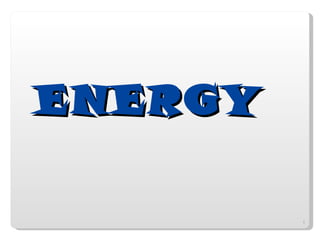
Nutrition and energy
- 1. ENERGY
- 8. WMSU BSND Review 2007
- 22. Economics of Fasting WMSU BSND Review 2007
- 28. Positive & Negative Energy Balance
- 30. A Cascade of Regulation: Hunger Appetite Satiation and Satiety
- 31. WMSU BSND Review 2007
- 39. Energy Balance: Energy Expenditure
- 42. Example: Female, IBW = 56 kgs. BMR = 1276.8 kcal/day Activity = Light activity (30%) PA = BMR x Activity = 1276.8 kcal/day x 30% = 383.04 kcal/day
- 45. Table 6. Proposed BMI Classification by FAO/WHO (RENI, 2002) Classification BMI (kg/m 2 ) Risk of co-morbidities Underweight < 18.5 Low Normal Range 18.5 – 24.9 Average Overweight 25.0-29.9 Increased Obese 30-39.9 Moderate Extreme obese > 40 Severe
- 53. Fat Metabolism WMSU BSND Review 2007
- 54. Pancreatic Hormones, Insulin & Glucagon Regulate Metabolism
- 62. Table 1. Effects of Alcohol on the Brain Blood R-OH Conc. Effect on Brain 0.05 Impaired judgment, relaxed inhibitions, altered mood, increased heart rate 0.10 Impaired coordination, delayed reaction time, exaggerated emotions, impaired peripheral vision, impaired ability to operate a vehicle 0.15 Slurred speech, blurred vision, staggered walk, seriously impaired coordination and judgment 0.20 Double vision, inability to walk 0.30 Uninhibited behavior, stupor, confusion, inability to comprehend 0.40-0.60 Unconsciousness, shock, coma, death due to cardiac or respiratory failure
- 63. Table 2. Alcohol Doses and Blood Levels No. of Drinks Percentage of blood alcohol by body weight 100 lbs 120 lbs 150 lbs 180 lbs 200 lbs 2 0.08 0.06 0.05 0.04 0.04 4 0.15 0.13 0.10 0.08 0.08 6 0.23 0.19 0.15 0.13 0.11 8 0.30 0.25 0.20 0.17 0.15 12 0.45 0.36 0.30 0.25 0.23 14 0.52 0.42 0.35 0.34 0.27
- 64. Table 3. Health Effects of Alcohol Consumption What is the health problem? What is the effect of alcohol? Arthritis Increased risk of having gout Cancer Increased risk of cancer of the liver, rectum, breast, pancreas, mouth, throat: very harmful when combined with tobacco or nicotine Fetal alcohol syndrome Causes permanent physical, behavior, mental abnormalities in the fetus Heart Disease Raises blood pressure, blood lipids, and increased risk for stroke Diabetes May increase or decrease blood glucose levels
- 65. Table 3. Health Effects of Alcohol Consumption What is the health problem? What is the effect of alcohol? Kidney problems Enlarges the kidneys Liver disease Fatty liver, cancer of the liver Malnutrition Increased risk of having PEM and other vitamin/mineral deficiencies Nervous disorders Causes dementia, impairs balance and memory Obesity Increased energy intake Psychological disturbances Causes depression, anxiety and insomnia
- 66. Table 4. Myths and Truths about Alcohol Myths Fact Alcohol warms the body. Blood is momentarily diverted to skin overall effect is a cooling one Wine and beer do not lead to addiction. Substance abuse is directly related to amounts consumes and is not dependent on the kind of alcoholic beverage consumed Mixing drinks gives a hangover. Excessive alcohol intake of any kind results in a hangover Walking will “sober up” a person. Alcohol metabolism is time-dependent. Only liver cells not muscle cells can metabolize alcohol
- 67. Table 4. Myths and Truths about Alcohol Myths Fact Caffeine offsets the effects of alcohol. Caffeine is a stimulant but will not speed up alcohol metabolism Driving coordination is still impaired after a night of drinking. Allow at least 24 hours for alcohol to be metabolized completely
- 68. NUTRITION AND PHYSICAL FITNESS
- 72. Excessive Exercise Risks Children Energy needs not achieved and limited growth and development Teens Inadequate energy intake Dietary protein used for energy Amenorrhea Negative calcium balance and reduced bone mass Sports anemia Adults Possible increased need for riboflavin and vitamin B6 Exercise-related injuries Pregnant Women Low weight gain Low-birth-weight infant Nursing mothers Excessive rate of weight loss, reducing milk production and limiting the infant growth Older adults Exercise-related injuries leading to disability
- 82. Factors Related to Exercise Program Adherence Biological Factors Relative body fat Overweight Psychological Factors Self motivation Self efficacy Attainment of exercise goals Depression/anxiety/introversion
- 83. Factors Related to Exercise Program Adherence Social Factors Family Support Family Problems Exercise/job Conflicts Income and education levels Behavioral Factors Smoking Leisure time Credit training Type A behavior prone
- 84. Factors Related to Exercise Program Adherence Program Factors Social support Location and convenience of exercise facility Exercise leadership and supervision Initial exercise intensity Variety of exercise modes Program costs
- 91. Energy Requirements During Performance
- 92. How the Body Stores Energy Glycogen in liver Fat in adipose Tissues Glycogen is used to top-up the blood glucose level Majority of glycogen is stored in muscles
- 95. Intensity and Duration Activity Intensity Activity Duration Preferred Source Fuel Oxygen Needed Activity Example Extreme < 30s ATP NO Shot put Very High 30s – 3m Carb NO ¼ mile run High 3 - 20m Carb and some fats YES cycling, swimming Moderate > 20m Fat and some carbs YES hiking
- 96. FLUID INTAKE The following are the guidelines to ensure adequate fluid replacement, leading to optimal performance a. Eat a nutritionally balanced diet and drink adequate fluids during the 24-hour period before an event b. Consume 2 cups of fluid 2 hours before exercise followed by another 2 cups 15 to 20 minutes before exercise and 4 to 6 oz fluid every 10 to 15 minutes during exercise. c. Drink cool beverages to reduce body core temperature. d. Consume sports drink to enhance fluid intake and absorption and help delay fatigue in endurance events lasting longer than 1 hour. e. After exercise, consume sports drink to enhance palatability and further promote fluid replacement.